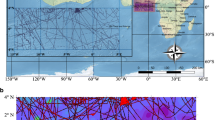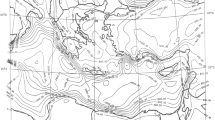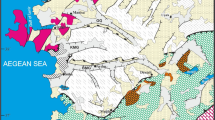Abstract
We present an estimation of depth of anomalous bodies using normalized full gradient (NFG) of gravity anomaly. Maxima in the NFG map can locate the bodies and indicate their depth. Model calculation using a sphere and application of the NFG method to gravity anomalies over salt domes in the USA and Denmark shows effectiveness of the method. However, the accuracy of depth estimation strongly depends on the number of term N in the Fourier series used to calculate the NFG. An optimum N for the calculation can be given from a test.
Similar content being viewed by others
References Cited
Aydin, A., 2005. Evaluation of Gravity Anomalies by Direct Interpretation Techniques: An Application from Hasankale-Horasan Region. Journal of Engineering Sciences, 11(1): 95–102
Berezkin, V. M., 1967. Application of the Total Vertical Gradient of Gravity for Determination of the Depths to the Sources of Gravity Anomalies. Exploration Geophysics, 18: 69–79 (in Russian)
Berezkin, V. M., 1973. Application of Gravity Exploration to Reconnaissance of Oil and Gas Reservoirs. Nerdra Publishing House, Moscow (in Russian)
Dondurur, D., 2005. Depth Estimates for Slingram Electromagnetic Anomalies from Dipping Sheet-Like Bodies by the Normalized Full Gradient Method. Pure Applied Geophysics, 162(11): 2179–2195
Madirazza, I., 1980. Structural Geology of Linde, Gording and Mors Salt Diapirs. Proc. Radioactive Waste Disposal Symposium, ELSAM. Frederecia, Denmark. 75–90
Nettleton, L. L., 1976. Gravity and Magnetics in Oil Prospecting. McGraw-Hill, New York. 464
Pasteka, R., 2000. 2D Semi-Automated Interpretation Methods in Gravimetry and Magnetometry. Acta Geologica Universitis Comenianae, 55: 5–50
Salem, A., Elawadi, E., Ushijima, K., 2003. Depth Determination from Residual Gravity Anomaly Data Using a Simple Formula. Computers & Geosciences, 29(6): 801–804
Saxov, S., 1956. Some Gravity Measurements in Thy, Mors, and Vendsyssel. GIS, 25(3): 48
Tran, D. T., 2004. Two and Three Dimensional Normalized Total Gradient of Gravity Anomalies and Its Application for Detecting the Oil-Gas Potential Areas in the Southeast Sedimentary Basins of the East Vietnam Sea. Proc. 7th SEGJ International Symposium—Imaging Technology. Sendai, Japan
Zeng, H., Meng, X., Yao, C., et al., 2002. Detection of Reservoirs from Normalized Full Gradient of Gravity Anomalies and Its Application to Shengli Oil Field, East China. Geophysics, 67(4): 1138–1147
Author information
Authors and Affiliations
Corresponding author
Additional information
This study was supported by the Ministry of Science, Researches and Technology, Iran.
Rights and permissions
About this article
Cite this article
Aghajani, H., Moradzadeh, A. & Zeng, H. Estimation of depth to salt domes from normalized full gradient of gravity anomaly and examples from the USA and Denmark. J. Earth Sci. 20, 1012–1016 (2009). https://doi.org/10.1007/s12583-009-0088-y
Received:
Accepted:
Published:
Issue Date:
DOI: https://doi.org/10.1007/s12583-009-0088-y




